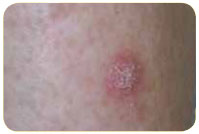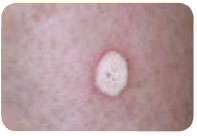Page last updated: January 2024
The information on this webpage was adapted from Understanding Skin Cancer - A guide for people with cancer, their families and friends (2024 edition). This webpage was last updated in January 2024.
Expert content reviewers:
This information was developed based on Australian clinical practice guidelines, and with the help of a range of health professionals and people affected by skin cancer:
- A/Prof Victoria Mar, Director, Victorian Melanoma Service, Alfred Hospital and Monash University, VIC
- Tracey Bilson, Consumer
- Raelene Buchan, Consumer
- Alison Button-Sloan, Consumer
- Dr Margaret Chua, Radiation Oncologist, and the Skin Radiation Oncology team, Peter MacCallum Cancer Centre, VIC
- Prof Anne Cust, Deputy Director, The Daffodil Centre, The University of Sydney and Cancer Council NSW Chair, National Skin Cancer Committee, Cancer Council, and faculty member, Melanoma Institute Australia
- A/Prof Paul Fishburn, Skin Cancer Doctor, Norwest Skin Cancer Centre, NSW and Faculty of Medicine, University of Queensland
- Danielle Goss, Melanoma Clinical Nurse Specialist, Amie St Clair Melanoma (part of Melanoma Institute Australia), Wagga Wagga, NSW
- Louise Pellerade, 13 11 20 Consultant, Cancer Council WA
- Dr Shireen Sidhu, Head of Dermatology, The Royal Adelaide Hospital, SA
- Dr Amelia Smit, Research Fellow – Melanoma and Skin Cancer, The Daffodil Centre, The University of Sydney and Cancer Council NSW
- Dr Tony Tonks, Plastic and Reconstructive Surgeon, Canberra Plastic Surgery, ACT
Non-melanoma skin cancer is treated in different ways. The treatment recommended by your doctors will depend on:
- the type, size and location of the cancer
- your general health
- any medicines you are taking (these may increase the risk of bleeding after surgery or delay healing)
- whether the cancer has spread to other parts of your body.
If the excision biopsy removed all the cancer, you may not need any further treatment.
Treatment of sunspots and superficial skin cancer
Some sunspots may need treatment if they are causing symptoms or to prevent them becoming cancers.
Skin cancer that affects cells only on the surface of the top layer of the skin is called superficial.
Treatment options for superficial BCC and SCC in situ (Bowen’s disease) include curettage and electrodesiccation (also known as cautery) , freezing, topical creams and photodynamic therapy.
Surgery is not always used for superficial BCC and SCC in situ. It may be used if the diagnosis is uncertain or if the area of abnormal tissue does not respond to non-surgical treatments.
Speak to a cancer nurse
Surgery
Surgery to remove the cancer (surgical excision) is the most common treatment for invasive BCC and SCC. Most small skin cancers are removed by a GP or dermatologist in their consulting rooms. A surgeon may treat more complex cases.
The doctor will inject a local anaesthetic to numb the affected area, then cut out the skin cancer and some nearby normal-looking tissue (margin).
This margin may be very small or around one centimetre depending on the type of skin cancer and where it is on your body.
A pathologist checks the margin for cancer cells to make sure the cancer has been completely removed. The results will be available in about a week. If cancer cells are found at the margin, you may need further surgery or radiation therapy.
Mohs micrographic surgery
Mohs micrographic surgery is usually done under local anaesthetic by a Mohs trained dermatologist or a Mohs specialist. It is used to treat skin cancers that have poorly defined edges or are in areas that are hard to treat.
This procedure is done in stages. The doctor removes the cancer little by little and checks each section of tissue under a microscope. They keep removing tissue until they see only healthy tissue under the microscope.
Only some skin cancers are suitable for Mohs surgery. This technique costs more than other types of surgery. Special equipment and training are needed so it’s available only at some hospitals or clinics.
Repairing the wound after surgery
Most people will be able to have the wound closed with stitches. You will have a scar, which should be less noticeable over time. The area around the excision may feel tight and tender for a few days.
If you have a large skin cancer removed, your doctor will talk with you about what type of reconstruction is suitable for your wound. This may be a:
- skin flap – nearby loose skin and underlying fatty tissue is moved over the wound and stitched
- skin graft – a thin piece of skin is removed from another part of the body (the donor site) and stitched over the wound. The donor site may be stitched, or it may be dressed and allowed to heal by itself.
Skin flaps and grafts are often done as day surgery in hospital under a local or general anaesthetic, but may be done in a doctor's rooms. The affected area will heal over a few weeks.
Whether you have an excision or Mohs surgery, sometimes you may need a more complex reconstructive procedure. This can involve more than one reconstruction technique, surgery that is done in stages, and a longer stay in hospital.
Curettage and electrodesiccation
Curettage and electrodesiccation is used to treat some BCCs, small SCCs, and areas of SCC in situ (Bowen’s disease).
The doctor will give you a local anaesthetic and then scoop out the cancer using a small, sharp, spoon-shaped instrument called a curette.
Low-level heat will be applied to stop the bleeding and destroy any remaining cancer. The wound should heal within a few weeks, leaving a small, flat, round, white scar.
Some people may have cryotherapy after curettage to destroy any remaining cancer cells.
Cryotherapy
 Before cryotherapy
Before cryotherapy
 After cryotherapy
After cryotherapy
Cryotherapy, or cryosurgery (freezing), is a procedure that uses extreme cold (liquid nitrogen) to remove sunspots, some small BCCs and SCC in situ (Bowen’s disease).
The GP or dermatologist sprays liquid nitrogen onto the sunspot or skin cancer and a small area of skin around it. You may feel a burning or stinging sensation, which lasts a few minutes.
The liquid nitrogen freezes and kills the abnormal skin cells and creates a wound. In some cases, the procedure may need to be repeated. The treated area will be sore and red. A blister may form soon after. A few days later, a crust will form on the wound.
The dead tissue will start to fall off 1–6 weeks later, depending on the area treated. New, healthy skin cells will grow and a scar may develop. The healed skin will probably look paler than the surrounding skin.
Topical treatments
Some skin spots and superficial skin cancers can be treated with creams or gels that you apply to the skin. These are called topical treatments. They may contain immunotherapy or chemotherapy drugs, and are prescribed by a doctor.
Only use these treatments on the specific spots or areas that your doctor has asked you to treat. Don’t use leftover cream on spots that have not been assessed by your doctor.
Immunotherapy cream
A cream called imiquimod is a type of immunotherapy that causes the body’s immune system to destroy cancer cells. Imiquimod is used to treat sunspots and superficial BCCs.
Your doctor will explain how to apply the cream and how often. For superficial BCCs, the cream is commonly applied directly to the affected area at night, usually five days a week for six weeks.
Within days of starting imiquimod, the treated skin may become red, sore and tender. It may peel and scab over before it gets better.
Some experience pain or itching in the affected area, fever, achy joints, headache and a rash. If you notice any of these more serious side effects, stop using the cream and see your doctor immediately.
Chemotherapy cream
A cream called 5-fluorouracil (5-FU) is a type of chemotherapy drug. It is used to treat sunspots and, sometimes, SCC in situ (Bowen’s disease).
5-FU works best on the face and scalp. Your GP or dermatologist will explain how to apply the cream and how often. Many people use it twice a day for 2–4 weeks. It may need to be used for longer for some skin cancers.
While using the cream, your skin will be more sensitive to UV radiation and you will need to stay out of the sun. The treated skin may become red, blister, peel and crack, and feel uncomfortable.
These effects will usually settle within a few weeks of treatment finishing.
Radiation cream
As at December 2023, there are no guidelines or recommendations on the use of topical radiation creams such as Rhenium-188.
Information on its effectiveness and side effects is needed before it may be considered a standard treatment.
Photodynamic therapy
Photodynamic therapy (PDT) uses a cream that kills cancer cells when a special light is applied. It is used to treat sunspots, superficial BCCs and SCC in situ (Bowen’s disease). This treatment may have a high cost.
After gently scraping the area to remove any dry skin or crusting, the doctor applies a cream to the skin. After three hours, light is used to activate the cream.
The area is covered with a bandage. For skin cancers, PDT is usually repeated 1–2 weeks later.
Side effects can include redness and swelling, which usually ease after a few days. PDT commonly causes a burning, stinging or tender feeling in the treatment area, particularly to the face.
Your doctor may treat these side effects with a cold water spray or pack, or give you a local anaesthetic to help ease any discomfort.
Radiation therapy
Radiation therapy uses a controlled dose of radiation to kill or damage cancer cells so they cannot grow, multiply or spread.
It is used as the main treatment for BCCs or SCCs that are not suitable to be removed surgically, for large areas, or for people not fit enough for surgery.
Sometimes radiation therapy is also used after surgery to reduce the chance of the cancer coming back or spreading.
Radiation therapy to treat skin cancer is given from outside the body (externally). Your treatment plan will depend on the type and position of the cancer, and your preferences and circumstances.
This means that the number of treatments and the technique used can vary, and may take 2–7 weeks to complete.
Skin in the treatment area may become red, dry and sore 7–10 days after treatment starts. This soreness may get worse after treatment has finished but it usually improves within six weeks.
The treatment team will recommend creams to use to make you more comfortable.
Advanced skin cancer
A very small number of BCCs and SCCs spread to the lymph nodes or other areas of the body.
To work out if the skin cancer has spread, your doctor will feel nearby lymph nodes and may recommend a biopsy, imaging scans or other tests.
You may be referred to a cancer specialist called a medical oncologist, who will explain your treatment options.
Learn more about advanced cancer